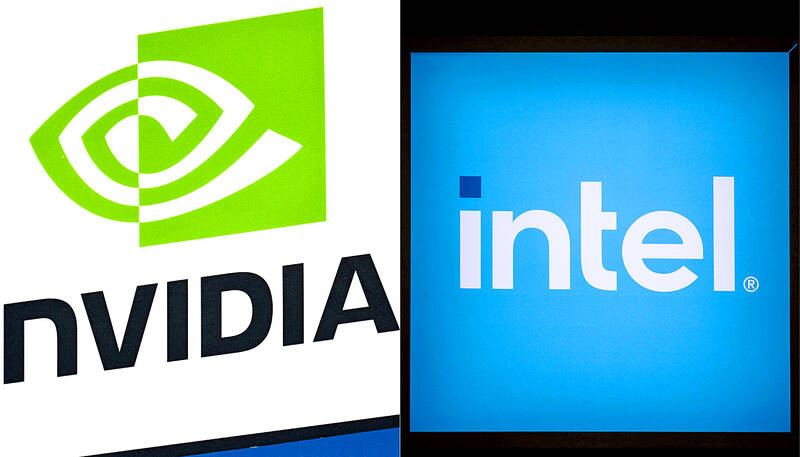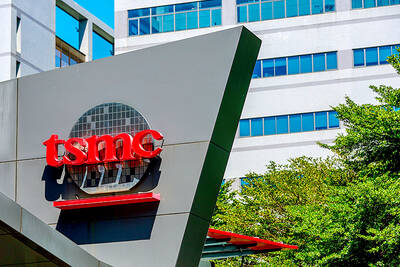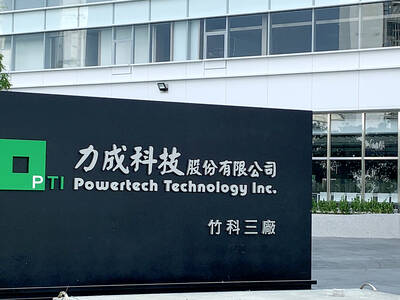Nvidia Corp announced yesterday that it’s investing US$5 billion in Intel Corp and will collaborate with the struggling semiconductor company.
The two companies will team up to work on custom data centers that form the backbone of artificial intelligence (AI) infrastructure as well as PC products, Nvidia said in a statement.
Nvidia said it will spend US$5 billion to buy Intel common stock at US$23.28 a share. The investment, which is subject to regulatory approvals, comes a month after the US government took a roughly 10 percent stake in Intel.

Photo: Hector Retamal and Fabrice Coffrini, AFP
“This historic collaboration tightly couples Nvidia’s AI and accelerated computing stack with Intel’s CPUs and the vast x86 ecosystem — a fusion of two world-class platforms," Nvidia CEO Jensen Huang (黃仁勳) said in the statement. “Together, we will expand our ecosystems and lay the foundation for the next era of computing.”
The two companies said they will work on “seamlessly connecting” their architectures.
For data centers, Intel will make custom chips that Nvidia will use in its AI infrastructure platforms. While for PC products, Intel will build chips that integrate Nvidia’s graphics technology.
The agreement provides a lifeline for Intel, which was a Silicon Valley pioneer that enjoyed decades of growth as its processors powered the PC boom, but fell into a slump after missing the shift to the mobile computing era unleashed by the iPhone’s 2007 debut.
Intel fell even farther behind in recent years amid the AI boom that has propelled Nvidia into the world’s most valuable company. Intel lost nearly US$19 billion last year and another US$3.7 billion in the first six months of this year, and expects to slash its workforce by a quarter by the end of the year.
Now it is forced to turn to Taiwan Semiconductor Manufacturing Co (TSMC, 台積電) to produce its best chips. TSMC’s rapid improvements in technology have enabled many companies – from Apple Inc to Nvidia – to turn good designs into industry-leading products.
Under new CEO Lip-Bu Tan (陳立武), brought in earlier this year to replace the ousted Pat Gelsinger, Intel has said it will pursue a more open approach, seeking out partnerships and opening its plants to rivals.
“We appreciate the confidence Jensen and the Nvidia team have placed in us with their investment and look forward to the work ahead as we innovate for customers,” Tan said in the statement. “Intel’s x86 architecture has been foundational to modern computing for decades – and we are innovating across our portfolio to enable the workloads of the future.”
The deal between the two chipmakers comes as China moves to be less dependent on US semiconductor technology. This week, Chinese officials reportedly forbade several large domestic technology companies from purchasing Nvidia chips, and Huawei Technologies Co (華為) announced that it was expanding its development of AI chips and manufacturing.
In premarket trading yesterday, Intel shares jumped 30 percent. Nvidia shares added 3 percent.
Additional reporting by Bloomberg

RUN IT BACK: A succesful first project working with hyperscalers to design chips encouraged MediaTek to start a second project, aiming to hit stride in 2028 MediaTek Inc (聯發科), the world’s biggest smartphone chip supplier, yesterday said it is engaging a second hyperscaler to help design artificial intelligence (AI) accelerators used in data centers following a similar project expected to generate revenue streams soon. The first AI accelerator project is to bring in US$1 billion revenue next year and several billion US dollars more in 2027, MediaTek chief executive officer Rick Tsai (蔡力行) told a virtual investor conference yesterday. The second AI accelerator project is expected to contribute to revenue beginning in 2028, Tsai said. MediaTek yesterday raised its revenue forecast for the global AI accelerator used

Taiwan Semiconductor Manufacturing Co (TSMC, 台積電) has secured three construction permits for its plan to build a state-of-the-art A14 wafer fab in Taichung, and is likely to start construction soon, the Central Taiwan Science Park Bureau said yesterday. Speaking with CNA, Wang Chun-chieh (王俊傑), deputy director general of the science park bureau, said the world’s largest contract chipmaker has received three construction permits — one to build a fab to roll out sophisticated chips, another to build a central utility plant to provide water and electricity for the facility and the other to build three office buildings. With the three permits, TSMC

The DBS Foundation yesterday announced the launch of two flagship programs, “Silver Motion” and “Happier Caregiver, Healthier Seniors,” in partnership with CCILU Ltd, Hondao Senior Citizens’ Welfare Foundation and the Garden of Hope Foundation to help Taiwan face the challenges of a rapidly aging population. The foundation said it would invest S$4.91 million (US$3.8 million) over three years to foster inclusion and resilience in an aging society. “Aging may bring challenges, but it also brings opportunities. With many Asian markets rapidly becoming super-aged, the DBS Foundation is working with a regional ecosystem of like-minded partners across the private, public and people sectors

BREAKTHROUGH TECH: Powertech expects its fan-out PLP system to become mainstream, saying it can offer three-times greater production throughput Chip packaging service provider Powertech Technology Inc (力成科技) plans to more than double its capital expenditures next year to more than NT$40 billion (US$1.31 billion) as demand for its new panel-level packaging (PLP) technology, primarily used in chips for artificial intelligence (AI) applications, has greatly exceeded what it can supply. A significant portion of the budget, about US$1 billion, would be earmarked for fan-out PLP technology, Powertech told investors yesterday. Its heavy investment in fan-out PLP technology over the past 10 years is expected to bear fruit in 2027 after the technology enters volume production, it said, adding that the tech would